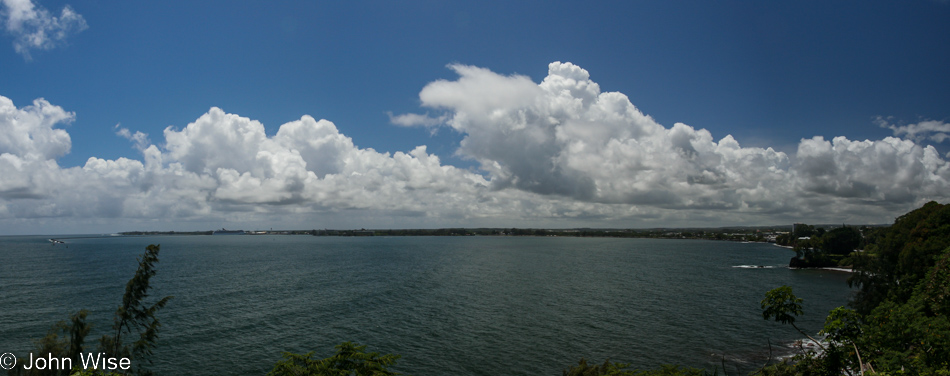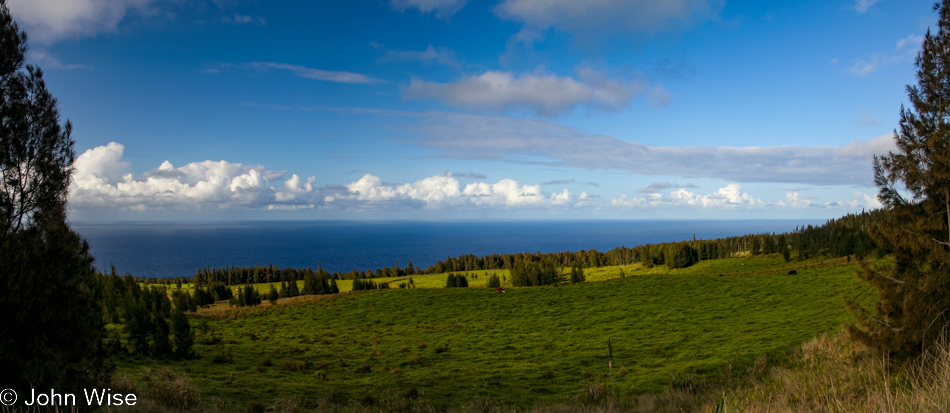
Disclaimer: Back in May of 2006, when I started posting about our vacation to the Hawaiian Islands, we were severely limited regarding photos I could share due to bandwidth limitations. Here in 2022, I’m updating these posts using the original image and text I shared, but I’m adding the rest of the photos I would have liked to share if bandwidth and storage had not been issues 16 years ago.
This is the Halema’uma’u Crater inside the Kilauea Caldera at Volcanoes National Park on the Big Island of Hawaii. Like most all things we visit, there seems to be a permanence of place that will survive well past the puny lifespan of our brief lives, but not here in the case of this crater.

The caldera floor we were looking at from an overlook had been dormant for 24 years, but two years after our visit, it was damaged by a small eruption. From that point forward, the floor of Halema’uma’u was an active lava lake with sporadic activity until the entire system started to collapse on May 1st, 2018. In the first six days of that episode the floor of the caldera sunk by 722 feet (220 meters). Only three months later, the crater was roughly 2,000 feet deep (600 meters), and the overlook was gone from the map.

We are accustomed to living things coming and going as the nature of life is all about constant change, but the rock we are living upon doesn’t seem to change within the scope of our lifetimes. Well, that’s not true at all, as evidenced by the rim of a volcanic crater where we once stood with the confidence that it would always look like that, only to be proven wrong. One might think that the planet, too, is a living thing.

A sprout emerges, and soon, a stalk thrusts upward toward the sun, and the arms of the fern unfold to capture the energy that will propel its life forward, allowing another cycle of life to bear fruit and spawn even more life. It all seems so symbiotic when I look at the plant in relation to the earth, and yet somehow, we humans can’t recognize that we should be in the same well-balanced position as the lowly plant.

The day before, we had taken the hike along the coast to see where the lava was entering the ocean; today, we focused on the caldera and visited a lava tube.

We are in Nāhuku (Thurston Lava Tube), where the phenomenon of turning semi-transparent while simultaneously witnessing the quantum entangled version of a person is a real thing. Maybe lava tubes are the planet’s microtubules, and we are undergoing a polymerization process in them, allowing us to grow our potential.

While the lava tubes did nothing for my obesity, I do think our potential for love and adventure was increased.

While yesterday saw us exploring the leeward side of the Big Island, today, we are taking time to better experience the windward side. Here we are at Ka Mauloa Church in Kurtistown, Hawaii, on Highway 11, where the Ho‘omana Na‘auao o Hawai‘i Organization continues the tradition of performing services in their native Hawaiian language, technically known as ʻŌlelo Hawaiʻi.

Leaving the Volcano Road, we reach Hilo Bay and merge onto the Mamalahoa Highway that will take us north.

For the next 10 miles, there is no plan other than seeing what the landscape looks like.

Once in a while, the sight of the extraordinary commands that we stop and try to capture the essence of this beautiful place.

There is no comparing any of this to the California, Oregon, or Washington coasts and obviously, it’s a million miles away in appearance and climate from the North Atlantic coast.

What’s not to love about the architecture found in Hawaii? Not the ugly Honolulu stuff we briefly saw on Oahu but this old-fashioned style that has a real character, such as Ishigo’s in Honomu.

We have entered the lands of the Akaka Falls State Park. Let me reiterate that for you, we are visiting AKAKA…Falls State Park.

I can only wonder about those who visit these islands for the beaches or volcanoes exclusively and fail to see these little details.

This Torch Ginger turns out to be edible, not that learning this while not in Hawaii is very useful.

One doesn’t really understand that moss and ferns grow on bamboo until seen with your own eyes.

This might be the most beautiful thing I’ll see today.

Even the Akaka Falls doesn’t compare to that fern in the previous photo, though this water falling into a bottomless pit is a spectacle one doesn’t see every day.

This is Apeepee Falls, the little cousin to Akaka. (I’ll bet $2 Caroline has groaned at least twice by now.) [Yep…]

If you are wondering if I could vulgarize Caroline’s drinking from this oversized nut of the Coco variety, you know I could, but I’m trying to hold back out of respect for her enjoying her very first sip of the freshest coconut water she’s ever had.

And with that, we ran out of things to do and hit the gas launching our car with us in it into the big blue ocean.

Would you believe that we were saved by a gaggle of mermaids who brought us to this Buddhist Temple of Honomu Hongwanji? Yeah, neither would I, although I’d like the idea of it being possible.

It is difficult to see here, but Caroline is holding a handful of plumeria, a flower she absolutely loves. It turns out that a German physician/botanist by the name of Dr. William Hillebrand first introduced the plumeria to the islands back in 1860.

Subsequently, in 1822, Dr. Zygmunt Kramsztyk, of Polish descent, introduced the Pacific Ocean to Hawaii. Before this gets out of hand, I just made up this part, but the plumeria story is true.

And with that, we ran out of things to do and hit the gas launching our car with us in it into the big blue ocean.

Would you believe that we were saved by a fever of forest nymphs who brought us to the Kalopa Native Forest State Park?

Only through the lens of hindsight do we really see the traits we were maybe not aware of when we were trudging through our adventures, and in this instance, looking back from 2022, I see that we were big on short trails. I know that, in part, this was due to trying to capture as many experiences as possible, but here in this last third of our life, we now aim for more immersive, longer jaunts into the nature we find ourselves able to access. Maybe in some way, it’s like my overeating, afraid that I’ll never have something so yummy ever again, I want all that I can gobble down regardless of how much I might overeat. Not sure we’d ever see Hawaii again; see everything as fast as we can.

I think I might have been wrong about that previous fiddlehead image, and this could actually be the most beautiful thing I’ll see today.

Over on the mainland, when fall rolls around, leaves turn orange, red, and yellow, you know, fall colors, while here in Hawaii, during the spring, apparently leaves turn pink and magenta.

It was at this point Caroline admonished me that if I continued this exercise of taking thousands of photos, I’d never be able to choose just one to best represent the day on my blog. Little did she know that in the future, I’d be able to update this post to include 40 to 50 images here in 2022. I’m anticipating that if I should live to be 80 years old, in 2043, I’ll be once again updating this post to possibly well over 100 images, and we’ll know who got the last laugh then.

And with that, we ran out of things to do and hurled ourselves over the landscape into the big blue ocean.

Would you believe that we were saved by a pod of three-legged whales that brought us to the Honokaa People’s Theatre, where we are still telling this tall tale to this day?

Waipiʻo Valley Lookout is the edge of today’s universe for the two of us. While a road takes travelers further north, we’ll have to save that for a visit in the future. We have to return to Hilo.

This is the three-legged mermaid forest nymph that saved me today and every other day.

Our date in Hilo had us returning for the evening festivities here at the Merrie Monarch Festival.

Hula is not just grass skirts as a matter of fact, as far as I can tell, the clothing doesn’t really matter as the art form is all about the hand gestures representing words, chants telling of important histories, and the music that accompanies the storytelling in order to create a narrative.

Knowing this bit of background, I want subtitles for these performances so I might learn something about the history of the Hawaiian people through their songs.

Early encounters with white Christian zealots tried to dissuade the Hawaiians from practicing Hula as they saw its roots in paganism, and so they thought it evil and against god. Two hundred years later, the religious fanaticism of the Christian right has hardly advanced, but while they concern themselves with abortion and trying to find new ways to suppress various ethnicities, Hawaiian culture fights to maintain itself through gentrification and the loss of their lands.

I wish I didn’t bring up these cultural imperialistic tragedies, but being in Hawaii screams at me what is probably lost forever and what is yet to disappear. In my view, none of what identifies a Hawaiian should ever be lost, especially to the superficial nonsense that is capitalism and its flamethrower of total destruction.

I have no idea what the words are that are being said here with these women’s hands, but I’m going to go with the idea that they are welcoming their traditions, gods, and ancestors.